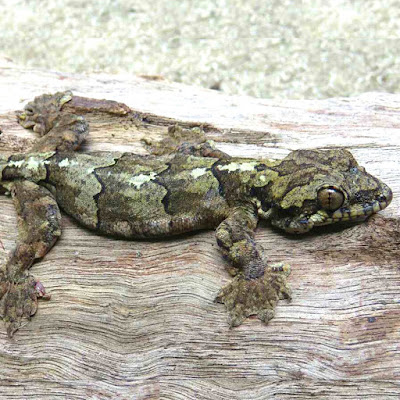[Most Recent Entries] [Calendar View]
Wednesday, November 7th, 2018
| Time | Event | ||||
| 4:11a | [Herpetology • 2018] Ptychozoon popaense • Geographically Structured Genetic Variation in Ptychozoon lionotum (Squamata: Gekkonidae) and A New Species from An Isolated Volcano in Myanmar
Abstract A molecular phylogenetic analysis of Parachute Geckos (Genus Ptychozoon Kuhl & van Hasselt, 1822) based on the mitochondrial gene ND2 indicates that a newly discovered population from the Mt. Popa volcano—a habitat island in the northern portion of the Bago Yoma mountains, Myanmar—is a new species, Ptychozoon popaense sp. nov. This species is part of a clade that contains P. bannanense Wang, Wang, & Liu, 2016 and P. lionotum Annandale, 1905 of Indochina. Ptychozoon popaense sp. nov. is morphologically most similar to its sister species P. lionotum which manifests considerable geographic substructuring of genetic variation but differs from the nominate taxon by an uncorrected pairwise sequence divergence of 16.0–17.1% and by discrete differences in morphology and color pattern. This discovery highlights the unique, insular nature of the Bago Yoma mountains of the Ayeyarwady Basin, which support other endemic gekkonids. It also underscores the growing diversity in this highly derived clade of cryptic, parachuting, geckos characterized by highly divergent genetic lineages, which may indicate the presence of additional, unrecognized species. Keywords: Reptilia, Squamata, Phylogenetic taxonomy, Mt. Popa, Ayeyarwady Basin
Ptychozoon popaense sp. nov. Mt. Popa Parachute Gecko .... Distribution. Ptychozoon popaense is know only from the type locality from ..., Mt. Popa, Mandalay Region, Myanmar (Fig. 1). Etymology. The gender of the genus Ptychozoon is neutral, therefore the specific epithet popaense is the adjective used here in reference to the type locality, Mt. Popa, Mandalay Region. Natural history. The type material was collected in deciduous dipterocap forest (Fig. 3). Both specimens were found on the walls of a small wooden building while foraging for insects during the evening at approximately 1900 hrs. L. Lee Grismer, Perry L. Jr. Wood, Myint Kyaw Thura, Marta S. Grismer, Rafe M. Brown and Bryan L. Stuart. 2018. Geographically Structured Genetic Variation in Ptychozoon lionotum (Squamata: Gekkonidae) and A New Species from An Isolated Volcano in Myanmar. Zootaxa. 4514(2); 202–214. DOI: 10.11646/zootaxa.4514.2.4 | ||||
| 6:02a | [Herpetology • 2018] Polymorphism and Synonymy of Brookesia antakarana and B. ambreensis, Leaf Chameleons from Montagne d’Ambre in north Madagascar
Abstract We examine the taxonomic status of two Malagasy leaf chameleon taxa, Brookesia antakarana Raxworthy & Nussbaum, 1995 and B. ambreensis Raxworthy & Nussbaum, 1995, integrating morphological and genetic evidence. Specimens assigned to these species occur in syntopy in Montagne d’Ambre, northern Madagascar, and were originally described based on differences in the shape of their pelvic shields. We found that the shape of these shields falls on a continuous spectrum, and detected only weak differences between the two taxa in a few other morphological features, all of which were correlated with shield length. Members of the two taxa (as assigned based on pelvic shield morphology) also showed extensive haplotype sharing in one nuclear and one mitochondrial marker. We conclude that at present there is no convincing evidence that these species are distinct, and act as first revisers in the sense of the International Code of Zoological Nomenclature to place B. ambreensis into the synonymy of B. antakarana. Key words: Squamata, Chamaeleonidae, morphology, molecular genetics, taxonomy, Amber Mountain, Antsiranana. Mark D. Scherz, Frank Glaw, Andolalao Rakotoarison, Melina Wagler and Miguel Vences. 2018. Polymorphism and Synonymy of Brookesia antakarana and B. ambreensis, Leaf Chameleons from Montagne d’Ambre in north Madagascar. SALAMANDRA. 54(4); 259-268. | ||||
| 6:02a | [PaleoOrnithology • 2012] Elaborate Plumage Patterning in A Cretaceous Bird
Abstract Integumentary patterns and colors can differentiate species, sexes, and life changes and can inform on habitat and ecology. However, they are rarely preserved in the fossil record. Here, we report on an extremely well-preserved specimen of the Cretaceous bird Confuciusornis with unprecedented complexity, including small spots on the wings, crest, and throat. Morphological and chemical evidence suggest that these patterns are produced by melanin, but unusual preservation prevents assignment of specific colors. Based on comparisons with extant birds, these patterns were likely used for camouflage, although other functions including sexual signaling cannot be ruled out. Our data show that even more elaborate plumage patterns than the spangles in Anchiornis and stripes in Sinosauropteryx were present at a relatively early stage of avian evolution, showing the significance of coloration and patterning to feather evolution. Conclusions: The elaborate spotting on this specimen exceeds that found in exceptionally-preserved troodontids and compsognathids and rivals that in modern birds, suggesting that plumage patterns evolved greater complexity through avian evolution. This hypothesis remains to be tested as more exceptionally-preserved specimens are described. Quanguo Li, Julia A. Clarke, Ke-Qin Gao, Jennifer A. Peteya and Matthew D. Shawkey. 2018. Elaborate Plumage Patterning in A Cretaceous Bird. PeerJ. 6:e5831. DOI: 10.7717/peerj.5831 |
| << Previous Day |
2018/11/07 [Calendar] |
Next Day >> |








